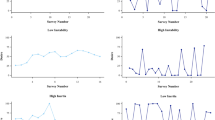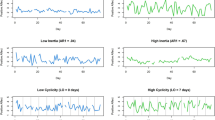Abstract
An extensive set of prospective data was examined for evidence of covariation between the timing of sexual desire and a number of menstrual cycle characteristics. In any given menstrual cycle, sexual desire was usually first experienced a few days before the basal body temperature (BBT) shift, around the expected ovulation date. Furthermore, positive correlations were found between the day of the BBT shift and the day of sexual desire onset, and between the length of the menstrual cycle and the temporal lag between the onset of sexual desire and the BBT shift. These results are consistent with a model in which sexual desire is affected by the same process that regulates the menstrual cycle. This process is presumably hormonal in nature, suggesting that hormonal factors contribute to sexual desire.
Similar content being viewed by others
References
Adams, D. B., Gold, A. R., and Burt, A. D. (1978). Rise in female-initiated sexual activity at ovulation and its suppression by oral contraceptives.N. Engl. J. Med. 299: 1145–1150.
Bancroft, J., Sanders, D., Davidson, D., and Warner, P. (1983). Mood, sexuality, hormones, and the menstrual cycle. III. Sexuality and the role of androgens.Psychosom. Med. 45: 509–516.
Cavanagh, J. R. (1969). Rhythm of sexual desire in women.Med. Aspects Hum. Sex. 3(2): 29–39.
Dobbins, J. G. (1980). Implication of a time-dependent model of sexual intercourse within the menstrual cycle.J. Biosoc. Sci. 12: 133–140.
Finney, D. J. (1971).Statistical Methods in Biological Assay 2nd ed., Griffin Press, London.
Green, D. M., and Swets, J. A. (1974).Signal Detection Theory and Psychophysics Robert E. Krieger, Hungington, NY.
Guerrero, R. (1978). The aging of gametes: The known and the unknown.Linacre Quart. 45: 345–357.
Hoon, P., Bruce, K., and Kinchloe, B. (1982). Does the menstrual cycle play a role in sexual arousal?Psychophysiology 19: 21–27.
James, W. H. (1971). Distribution of coitus within the human intermenstruum.J. Biosoc. Sci. 3: 159–171.
Mantel, N. (1966). Evaluation of survival data and two new rank order statistics arising in its consideration.Cancer Chemother. Rep. 50: 163–170.
Mantel, N., and Byar, D. P. (1974). Evaluation of response-time data involving transient states: An illustration using heart-transplant data.J. Am. Statist. Assoc. 69: 81–86.
Matteo, S., and Rissman, E. F. (1984). Increased sexual activity during the midcycle portion of the human menstrual cycle.Horm. Behav. 18: 249–255.
Morrell, M., Dixen, J. M., Carter, C. S., and Davidson, J. M. (1984). The influence of age and cycling status on sexual arousability in women.Am. J. Obstet. Gynecol. 148: 66–71.
Palmer, J. D., Udry, J. R., and Morris, N. M. (1982). Diurnal and weekly, but no lunar rhythms in human copulation.Human Biol. 54: 111–121.
Paranteau-Carreau, S. (1981). The sympto-thermal methods.Int. J. Fertil. 26: 170–181.
Persky, H., Charney, N., Lief, H. I., O'Brien, C. P. Miller, W. R., and Strauss, D. (1978). The relationship of plasma estradiol level to sexual behavior in young women.Psychosom. Med. 40: 523–535.
Rice, F. J., Lanctot, C. A., and Garcia-Devesa, C. (1981a). A crosscultural study of menstrual cycle characteristics of women practicing the sympto-thermal method of natural family planning. In Komnenich, P., McSweeney, M., Noack, J. A., and Elder, N. (eds.),The Menstrual Cycle, Vol. 2, Springer, New York, pp. 124–128.
Rice, F. J., Lanctot, C. A., and Garcia-Devesa, C. (1981b). Effectiveness of the sympto-thermal method of natural family planning: An international study.Int. J. Fertil. 26: 222–230.
Schreiner-Engel, P., Schiavi, R. C., Smith, H., and White, D. (1981). Sexual arousability and the menstrual cycle.Psychosom. Med. 43: 199–214.
Singer, I., and Singer, J. (1972). Periodicity of sexual desire in relation [sic] time of ovulation in women.J. Biosoc. Sci. 4: 471–481.
Spitz, C. J., Gold, A. R., and Adams, D. B. (1975). Cognitive and hormonal factors affecting coital frequency.Arch. Sex. Behav. 4: 249–263.
Stanislaw, H., and Rice, F. J. (1987). Acceleration of the menstrual cycle by intercourse.Psychophysiology 24: 714–718.
Udry. J. R., and Morris, N. M. (1977). The distribution of events in the human menstrual cycle.J. Reprod. Fertil. 51: 419–425.
Zuspan, K. J., and Zuspan, F. P. (1979). Basal body temperature. In Hafez, E. S. E. (ed.),Human Ovulation: Mechanisms, Prediction, Detection and Induction North-Holland, Amsterdam, pp. 291–298.
Author information
Authors and Affiliations
Rights and permissions
About this article
Cite this article
Stanislaw, H., Rice, F.J. Correlation between sexual desire and menstrual cycle characteristics. Arch Sex Behav 17, 499–508 (1988). https://doi.org/10.1007/BF01542338
Issue Date:
DOI: https://doi.org/10.1007/BF01542338




